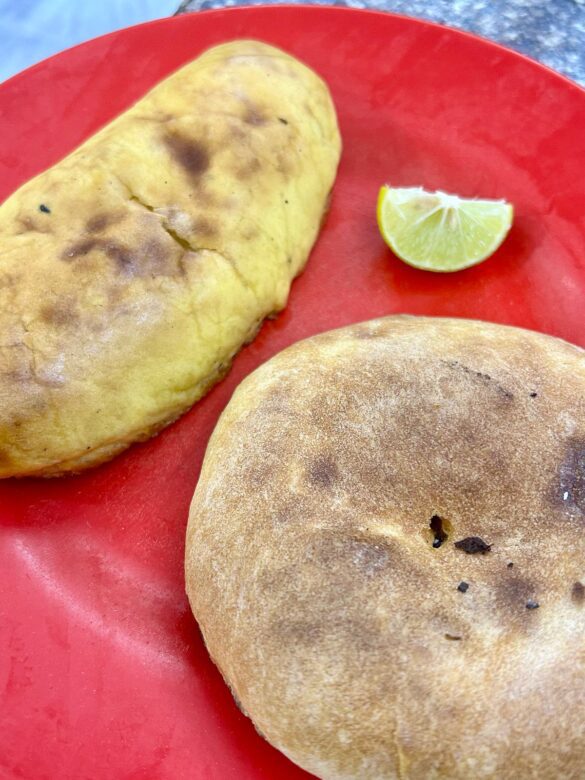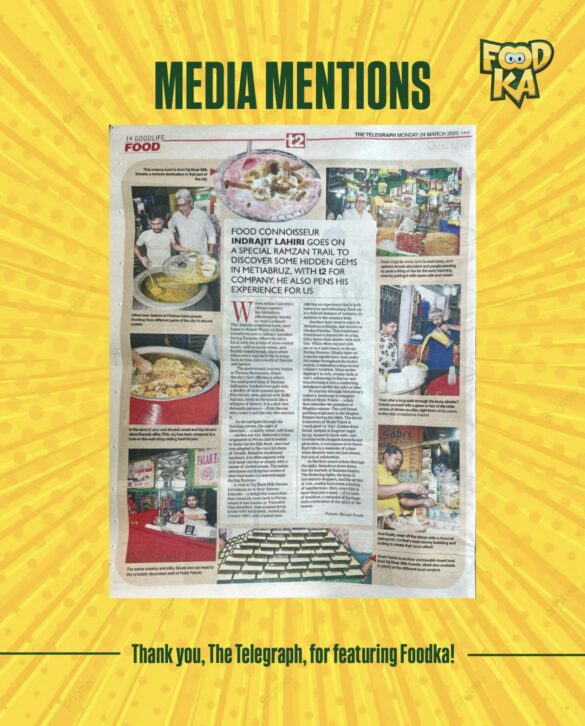As a die-hard non-vegetarian, biryani and kebabs have always been my culinary kryptonite. These rich and aromatic dishes transport me to the streets of Lucknow, where every bite feels like a brush with royalty. But, let’s face it, hopping on a plane to Lucknow every time a biryani craving hits isn’t practical. Fortunately, I found a piece of Lucknow right here in Kolkata – Metiabruz. Readers, let’s go for the Metiabruz food walk
Ramzan vs Sehri: The Culinary Differences Explained
Ramzan, the holy month of fasting observed by Muslims worldwide, is marked by two significant meals – Sehri (Suhoor) and Iftar. While both meals play a vital role in sustaining the body during the day-long fast, their purpose, timing, and culinary spread are distinctly different. Let’s explore the differences between Ramzan food for Sehri and Iftar.
| Aspect | Sehri (Suhoor) | Iftar |
|---|---|---|
| Timing | Pre-dawn meal, eaten before Fajr prayer. | Post-sunset meal, eaten after Maghrib prayer. |
| Purpose | To sustain energy and prevent hunger during the fast. | To break the fast and replenish the body. |
| Meal Type | Light yet filling, with a focus on slow-digesting foods. | Rich and flavorful, often lavish and celebratory. |
| Food Style | Nutrient-dense, hydrating, and energy-packed. | Festive, indulgent, and diverse. |
| Typical Dishes | – Parathas, oats, rice, whole wheat bread. – Eggs, yogurt, and lean meat for protein. – Hydrating fruits like watermelon and bananas. – Lassi or milk to prevent acidity. |
– Dates and water to break the fast. – Samosas, pakoras, and kebabs. – Hearty main courses like biryani, haleem, and nihari. – Desserts like phirni, sheer khurma, or jalebi. |
| Beverages | Water, milk, or lassi to prevent dehydration. | Sweet or tangy drinks like Rooh Afza, and lemonade. |
| Nutritional Focus | Balanced and slow-releasing energy for the day ahead. | Rehydration and replenishment of energy. |
| Cultural Practices | Often a quiet and personal meal with family. | Social and festive with larger gatherings. |
| Duration | Consumed around 3:30 AM – 4:30 AM (varies by region). | Consumed around 6:30 PM – 7:30 PM (varies by region). |
Metiabruz carries the legacy of Nawab Wajid Ali Shah, who brought with him the grandeur of Awadhi cuisine when he was exiled from Lucknow in the mid-19th century. Today, the streets of this lesser-known neighborhood are filled with the aromas of biryani, kebabs, and decadent desserts, making it a must-visit for every food lover.
Bichali Ghat & Khao Gali: The Culinary Gateway
Located on the banks of the Hooghly River, Bichali Ghat is where Nawab Wajid Ali Shah first set foot in Kolkata after being exiled from Awadh in 1856. This spot became the entry point for a cultural renaissance, as the Nawab brought with him not just his court but also the royal flavors of Awadhi cuisine.
Right next to Bichali Ghat lies Khao Gali – a bustling street food haven that keeps the Nawabi culinary tradition alive. This vibrant lane is a foodie’s paradise, offering a mouth-watering spread. And once you are on the Metiabruz food walk, this place is impossible to miss. The smoky aroma of freshly grilled kebabs and the sight of steaming biryanis create an immersive experience, transporting you straight to the royal kitchens of Awadh.
Nihari at Metiabruz
Speaking of nihari – this slow-cooked meat stew is a revelation. The velvety, spice-laden sauce clings to the tender meat, making every bite an indulgent experience. Traditionally enjoyed as a breakfast dish, nihari in Metiabruz is a late-night favorite, offering warmth and comfort to the soul.
Nihari, a rich and aromatic meat stew, traces its origins to the Mughal Empire in the 18th century. The word “Nihari” comes from the Arabic term “Nahar”, meaning morning, as this dish was traditionally enjoyed as a breakfast meal by Mughal nobles. It was slow-cooked overnight in large pots, allowing the spices and meat to blend perfectly by dawn.
Legend has it that Emperor Shah Jahan’s royal chefs created Nihari as a nourishing dish for his army, providing strength and warmth during the cold mornings. Over time, it became a culinary staple in Delhi, Lucknow, and Hyderabad, celebrated for its rich, velvety gravy and tender, slow-cooked meat.
Firdous restaurant, metiabruz
Firdous restaurant is a local favorite at Metiabruz and can not, or should not be missed during the Metiabruz food walk. Md Azam Ansari is the second-generation owner of this place and is doing his job pretty efficiently. The nihari here is pretty much well-bodied. The bone marrow has come out quite well, indicating a nice, long cooking time. You can have it with their Kulcha. Their Haleem is pretty average, if compared to other places in the city, but the Nihari stole the show. I could not find it on the Google map. The address is 263A, Rameswar Pur Road, Metiabruz.
Please note, that if you want to taste the Haleem at Firdous Restaurant, you need to come early by 6PM. The shahi Tukra is pretty average, and is easily skippable
Taj Ajmeri Hotel for Lucknow styled sheermal
Opposite the Noorie Masjid at Metiaburz, one small shop comes alive during Ramzan- Taj Ajmeri Hotel. No Nawabi meal is complete without its signature bread, and this place, on a sultry Metiabruz food walk, doesn’t disappoint either. they bring their bread cooks from Lucknow during the Ramzan time and prepare some killer stuff. Recommended.
Sheermal traces its origins to Persian cuisine, where it was traditionally made as a lightly sweetened flatbread infused with saffron. The name comes from the Persian words “sheer” (milk) and “mal” (to rub), referring to the milk used in the dough preparation. The bread traveled to the Indian subcontinent during the Mughal era, where it became a staple in royal kitchens.
In Awadhi and Hyderabadi cuisine, sheermal was often enjoyed with rich curries, kebabs, or nihari. Its golden hue, achieved by brushing with saffron milk, made it a visually striking addition to grand feasts. Today, sheermal is a delicacy in Metiabruz, adding a touch of sweetness to the region’s spicy Nawabi dishes.
In short:
- Sheermal: This slightly sweet, saffron-flavored flatbread is the perfect companion for rich curries.
- Kulcha: Soft and fluffy, sometimes stuffed with potato or paneer, it pairs wonderfully with kebabs and nihari.
Sweet Endings: Shahi Tukda, Falooda & Khajla
No culinary walk is complete without dessert, and Metiabruz offers plenty to satisfy your sweet tooth.
- Shahi Tukda: A royal Mughlai dessert made with fried bread soaked in sugar syrup, layered with rabri, and topped with nuts and saffron. Each bite is a rich, creamy delight.
- Falooda: At Taj Shah Milk Sweets, you’ll find one of the best Faloodas in town. This dessert drink, with rose syrup, basil seeds, vermicelli, and kulfi, offers a refreshing end to your meal.
- Khajla: Also known as Dhakai Paratha, this crispy, flaky fried bread is a Ramadan favorite. Best enjoyed with tea or dipped in creamy rabri, it’s a snack you’ll keep coming back for.
Taj Shah Milk Sweets
If you ask any local for Rana da’s shop, in all probability, you’ll be guided there. Opposite to that, is Taj Shah Sweets. This place is famous for its Falooda. This decadent dessert drink, with its Persian roots, has become a beloved street food staple in the City of Joy, offering sweet relief to locals and tourists alike. Kolkata’s falooda is a layered medley of flavors and textures. It typically starts with a base of silky vermicelli noodles, followed by sabja seeds (sweet basil seeds) soaked to a jelly-like consistency. Next comes a generous pour of creamy, rose-flavored milk, infusing the drink with its signature floral sweetness. The grand finale? A scoop (or two) of rich vanilla ice cream, garnished with slivers of nuts and a drizzle of rose syrup.
And on a hot summer evening, trust me, it’s brilliant.
Khajla at Shahi Sweets
Another tasty treat to enjoy in Metiaburuz is Khajla, also known as Dhakai paratha. And Shahi Sweets is a place, where, it’s readily available. The shop is nothing special- just your friendly neighborhood shop. But for this particular sweets, its a must-visit place during the Ramzan food walk at Metiabruz. Please check its location on google map here. This is a traditional fried bread that is crispy and flaky. This tasty snack is often enjoyed with tea or as a light snack on the go. During Ramadan, Khajla holds a special significance and is often sold under this name, even as it embodies a rich culinary tradition. Dipping it in rich, creamy milk or rabri enhances the flavour making it a comforting treat during festive times.
Go for it. Definitely definitely worth the sultry Metiabruz food walk.
Please check the Telegraph article on Metiabruz food walk
Metiaburuz is a testament to Kolkata’s diverse cultural landscape. Its rich history, vibrant community and delicious cuisine make it a hidden gem waiting to be discovered. A culinary treasure trove in the heart of Kolkata, this place preserves the rich legacy of Nawab Wajid Ali Shah’s gastronomic traditions. Its cuisine, marked by complex flavours and royal extravagance, offers a wonderful journey back in time. Whether you’re a foodie or simply enjoy a good meal, Metiaburuz promises an unforgettable dining experience.




